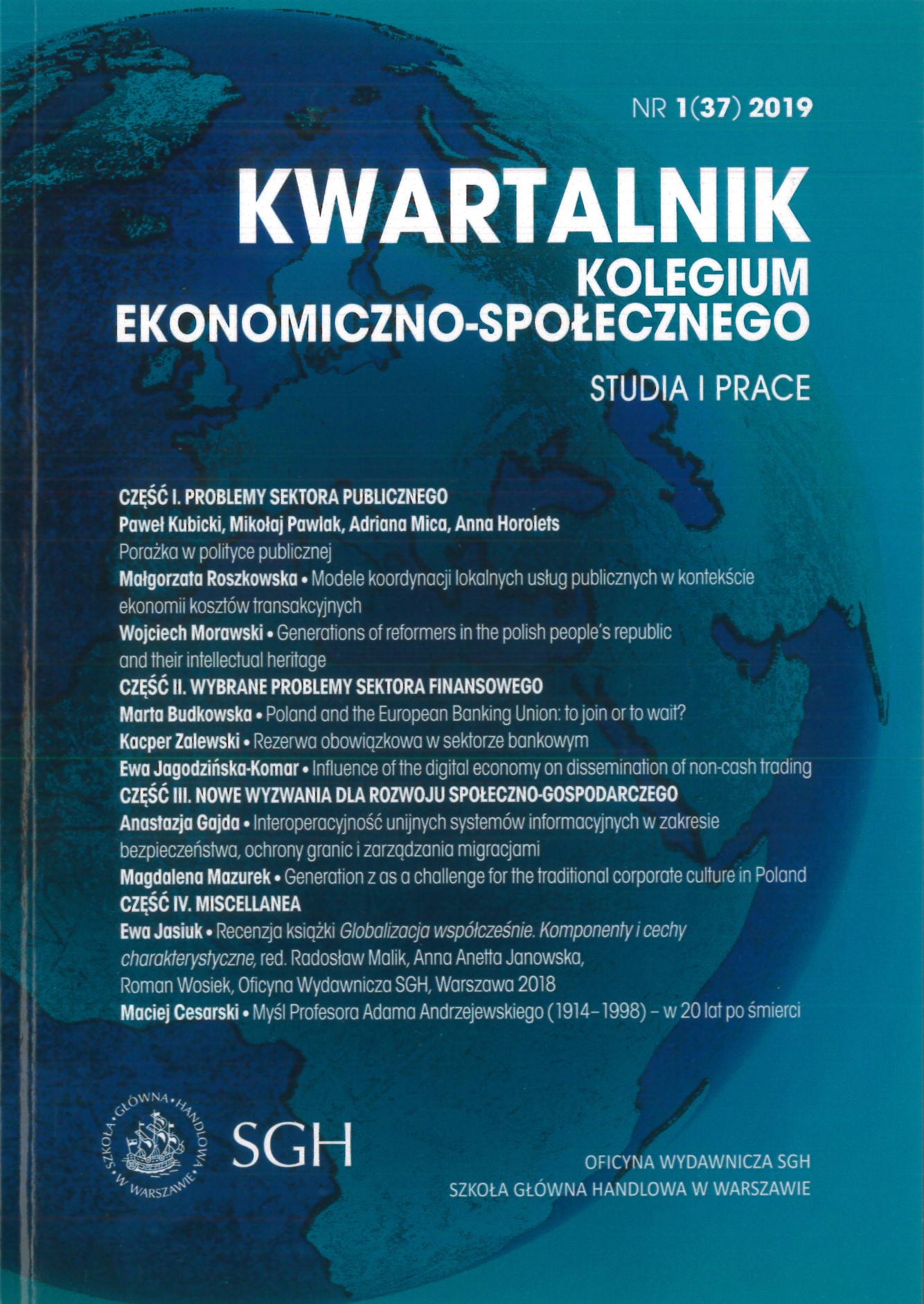The fractional reserve banking system
Main Article Content
Abstract
At the beginning of the 17th century the first public bank was established in Amsterdam. Its primary aim was to ensure high quality of the currency in circulation. Additionally, it provided a vault service to the citizens and organizations, e.g. trading companies. During first years a great attention was put on the security of the deposits, yet within next periods the bank started providing external financing, which accompanied with poor economic conditions led to the insolvency of the bank in the 19th century. The example presents two banking systems – full and fractional reserve. The full reserve requires from a bank keeping all deposits all the time, while the fractional reserve requires keeping a safe level of
deposits to ensure smooth operating of the business. At the same time, a monetary system developed, form the full gold standard to the issuer guarantee only. These two subjects have a lot in common and should not be analysed separately, which is done during public debate nowadays, and should be both considered while thinking about money supply and economic disturbances. Any law changes in the mandatory reserve area should be considered with respect to the monetary policy and other baking system aspects.
Downloads
Article Details
Autor (Autorzy) artykułu oświadcza, że przesłane opracowanie nie narusza praw autorskich osób trzecich. Wyraża zgodę na poddanie artykułu procedurze recenzji oraz dokonanie zmian redakcyjnych. Przenosi nieodpłatnie na Oficynę Wydawniczą SGH autorskie prawa majątkowe do utworu na polach eksploatacji wymienionych w art. 50 Ustawy z dnia 4 lutego 1994 r. o prawie autorskim i prawach pokrewnych – pod warunkiem, że praca została zaakceptowana do publikacji i opublikowana.
Oficyna Wydawnicza SGH posiada autorskie prawa majątkowe do wszystkich treści czasopisma. Zamieszczenie tekstu artykuły w repozytorium, na stronie domowej autora lub na innej stronie jest dozwolone o ile nie wiąże się z pozyskiwaniem korzyści majątkowych, a tekst wyposażony będzie w informacje źródłowe (w tym również tytuł, rok, numer i adres internetowy czasopisma).
Osoby zainteresowane komercyjnym wykorzystaniem zawartości czasopisma proszone są o kontakt z Redakcją.
References
2. Crockett A., Why is financial stability a goal of public policy?, „Federal Reserve Bank of Kansas City. Economic Review” 1997, vol. 82, no. 4, s. 5–22.
3. Crockett A., Daly H., Nationalize Money, Not Banks, CASSE, 2013, http://www.steadystate.org/nationalize-money-not-banks [dostęp 03.06.2018].
4. De Soto J.H., A Critical Analysis of Central Banks and Fractional-Reserve Free Banking from the Austrian School Perspective, „The Review of Austrian Economics” 1995, vol. 8, no. 2, s. 25–38.
5. De Soto J.H., A Critical Note on Fractional-Reserve Free Banking, „The Quarterly Journal of Austrian Economics” 1998, vol. 1, no. 4, Winter, s. 25–49.
6. Dorosiewicz Z., Wprowadzenie do finansów i bankowości, Wydawnictwo Naukowe PWN, Warszawa 2005.
7. Dow S., Johnsen G., Montagnoli A., A critique of full reserve banking, Sheffield Economic Research Paper Series no. 2015008, University of Sheffield, Sheffield 2015, s. 1–23.
8. Dyson B., Hodgson G., Lerven F. van, A response to critiques of „full reserve banking”, „Cambridge Journal of Economics” 2016, vol. 40, issue 5, s. 1351–1361.
9. Fedorowicz Z., Teorie pieniądza, Poltext, Warszawa 1992.
10. Fontana G., Sawyer M., Full Reserve Banking: More ‘Cranks’ Than ‘Brave Heretics’, „Cambridge Journal of Economics” 2016, vol. 40, issue 5, s. 1333–1350.
11. Galbraith J.K., Pieniądz. Pochodzenie i losy, PTE, Warszawa 2011.
12. Hulsmann J.G., Free Banking And Fractional Reserves: Reply To Pascal Salin, „The Quarterly Journal of Austrian Economics” 1998, vol. 1, no. 3, Fall, s. 67–71.
13. Hulsmann J.G., Free Banking and the Free Bankers, https://mises-media.s3.amazonaws.com/rae9_1_1_2.pdf?file=1&type=document [dostęp 29.07.2018].
14. Jeffrey C., Full Reserve Banking: An Analysis of Four Monetary Reform Plans, Sustainable Finance Lab, Utrecht 2013.
15. Lainà P., Proposals for full-reserve banking: history and critique from David Ricardo to Martin Wolf, „Economic Thought” 2015, vol. 4, no. 2, s. 1–20.
16. Machaj M., System rezerw cząstkowych a pusty pieniądz – co ważniejsze?, http://mises.pl/blog/2008/03/27/machaj-system-rezerw-czastkowych-a-pusty-pieniadz/
http://mises.pl/blog/2008/03/27/machaj-system-rezerw-czastkowych-a-pusty-pieniadz/ [dostęp 18.11.2017].
17. Martysz C., Bartlewski B., Podatek bankowy: koncepcja i studium przypadków, „INFOS” BAS, nr 3(241), Warszawa 2018, s. 1–4.
18. Mishkin F.S., The Economics of Money, Banking and Financial Markets, Pearson, Boston 2010.
19. Prescott E.C., Wessel R., Monetary policy with 100 percent reserve banking: An exploration, NBER Working Paper Series, Cambridge 2016.
20. Przybylska-Kapuścińska W., Rezerwa obowiązkowa jako instrument polskiej polityki pieniężnej, „Ruch Prawniczy, Ekonomiczny i Socjologiczny” 2002, nr 64, s. 131–148.
21. Raport KNF o sytuacji banków w I półroczu 2017 r.
22. Redukcja rezerw w styczniu?, „Prawo i Gospodarka”, 16.12.1998, s. 7.
23. Salin P., Free Banking and Fractional Reserves: A Comment on Jörg Guido Hülsmann, „Quarterly Journal of Austrian Economics” 1998, vol. 1, no. 3, s. 61–65.
24. Smith A.D., How to make a run-proof bank – Achieving maturity transformation without fractional reserves, Nathan QLD, Australia 2013.
25. Smith A.D., Monetary Policy, Banking Crises, and the Friedman Rule, AEA Papers and Proceedings, 2002.
26. Tymoczko D., Instrumenty interwencji banku centralnego na rynku pieniężnym, „Materiały i Studia”, z. 102, Narodowy Bank Polski, Warszawa 2000.
27. Ustawa z 29 sierpnia 1997 r. o Narodowym Banku Polskim, Dz. U. z 1997 r. Nr 140, poz. 938.
28. Williams J.C., Fractional Reserve Banking in Grain, „Journal of Money, Credit and Banking” 1984, vol. 16, no. 4, part 1, s. 488–496.
29. Wiśniewski M., Przerzucalność podatku bankowego w Polsce – próba oceny skali zjawiska, „Annales” UMCS, t. 51, nr 4, Lublin 2017, s. 99–112.
30. Zaleska M., Rezerwy obowiązkowe barierą rozwoju polskich banków, „Bank i Kredyt” 1999, nr 5, s. 41–48.
